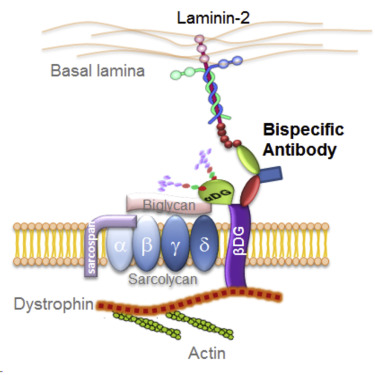当前位置:
X-MOL 学术
›
Mol. Ther.
›
论文详情
Our official English website, www.x-mol.net, welcomes your
feedback! (Note: you will need to create a separate account there.)
biAb Mediated Restoration of the Linkage between Dystroglycan and Laminin-211 as a Therapeutic Approach for α-Dystroglycanopathies.
Molecular Therapy ( IF 12.1 ) Pub Date : 2019-12-06 , DOI: 10.1016/j.ymthe.2019.11.023 Nathan Gumlaw 1 , Leila M Sevigny 1 , Hongmei Zhao 1 , Zhengyu Luo 1 , Dinesh S Bangari 1 , Elizabeth Masterjohn 1 , Yangde Chen 1 , Barbara McDonald 1 , Maureen Magnay 1 , Tara Travaline 1 , Takako Yoshida-Moriguchi 1 , Wei Fan 1 , David Reczek 1 , James E Stefano 1 , Huawei Qiu 1 , Christian Beil 1 , Christian Lange 1 , Ercole Rao 1 , Michael Lukason 1 , Elizabeth Barry 1 , William H Brondyk 1 , Yunxiang Zhu 1 , Seng H Cheng 1
Molecular Therapy ( IF 12.1 ) Pub Date : 2019-12-06 , DOI: 10.1016/j.ymthe.2019.11.023 Nathan Gumlaw 1 , Leila M Sevigny 1 , Hongmei Zhao 1 , Zhengyu Luo 1 , Dinesh S Bangari 1 , Elizabeth Masterjohn 1 , Yangde Chen 1 , Barbara McDonald 1 , Maureen Magnay 1 , Tara Travaline 1 , Takako Yoshida-Moriguchi 1 , Wei Fan 1 , David Reczek 1 , James E Stefano 1 , Huawei Qiu 1 , Christian Beil 1 , Christian Lange 1 , Ercole Rao 1 , Michael Lukason 1 , Elizabeth Barry 1 , William H Brondyk 1 , Yunxiang Zhu 1 , Seng H Cheng 1
Affiliation

|
Patients with α-dystroglycanopathies, a subgroup of rare congenital muscular dystrophies, present with a spectrum of clinical manifestations that includes muscular dystrophy as well as CNS and ocular abnormalities. Although patients with α-dystroglycanopathies are genetically heterogeneous, they share a common defect of aberrant post-translational glycosylation modification of the dystroglycan alpha-subunit, which renders it defective in binding to several extracellular ligands such as laminin-211 in skeletal muscles, agrin in neuromuscular junctions, neurexin in the CNS, and pikachurin in the eye, leading to various symptoms. The genetic heterogeneity associated with the development of α-dystroglycanopathies poses significant challenges to developing a generalized treatment to address the spectrum of genetic defects. Here, we propose the development of a bispecific antibody (biAb) that functions as a surrogate molecular linker to reconnect laminin-211 and the dystroglycan beta-subunit to ameliorate sarcolemmal fragility, a primary pathology in patients with α-dystroglycan-related muscular dystrophies. We show that the treatment of LARGEmyd-3J mice, an α-dystroglycanopathy model, with the biAb improved muscle function and protected muscles from exercise-induced damage. These results demonstrate the viability of a biAb that binds to laminin-211 and dystroglycan simultaneously as a potential treatment for patients with α-dystroglycanopathy.
中文翻译:

biAb介导的营养不良聚糖和层粘连蛋白211之间的连接的修复,作为α-营养不良的治疗方法。
α-营养不良性糖病(罕见的先天性肌营养不良症的亚组)的患者表现出一系列临床表现,包括肌肉营养不良,中枢神经系统疾病和眼部异常。尽管患有α-肌营养不良的患者在遗传上是异质的,但他们也存在肌营养不良蛋白α-亚基异常翻译后糖基化修饰的共同缺陷,这使其在与几种细胞外配体(如骨骼肌中层粘连蛋白-211),凝集素的结合中存在缺陷。神经肌肉接头,中枢神经系统中的神经毒素和眼中的皮卡丘林,导致各种症状。与α-营养不良性糖病的发展相关的遗传异质性对开发通用的治疗方法以解决遗传缺陷的范围提出了重大挑战。这里,我们提出了一种双特异性抗体(biAb)的开发,该抗体可作为替代分子接头来重新连接层粘连蛋白211和dystroglycanβ亚基,以减轻肌膜肌的脆性,这是α-dystroglycan相关的肌肉营养不良患者的主要病理学。我们显示,使用biAb改善LARGEmyd-3J小鼠(一种α-营养不良性糖病模型)的治疗可改善肌肉功能并保护肌肉免受运动引起的损伤。这些结果证明了同时结合层粘连蛋白211和营养不良糖聚糖的biAb的可行性,可作为治疗α-营养不良性糖尿病患者的潜在方法。α-dystroglycan相关的肌肉营养不良患者的主要病理。我们显示,使用biAb改善LARGEmyd-3J小鼠(一种α-营养不良性糖病模型)的治疗可改善肌肉功能并保护肌肉免受运动引起的损伤。这些结果证明了同时结合层粘连蛋白211和营养不良糖聚糖的biAb的可行性,可作为治疗α-营养不良性糖尿病患者的潜在方法。α-dystroglycan相关的肌肉营养不良患者的主要病理。我们显示,使用biAb改善LARGEmyd-3J小鼠(一种α-营养不良性糖病模型)的治疗可改善肌肉功能并保护肌肉免受运动引起的损伤。这些结果证明了与层粘连蛋白211和营养不良聚糖同时结合的biAb的可行性,可作为治疗α-营养不良患者的潜在方法。
更新日期:2019-12-06
中文翻译:

biAb介导的营养不良聚糖和层粘连蛋白211之间的连接的修复,作为α-营养不良的治疗方法。
α-营养不良性糖病(罕见的先天性肌营养不良症的亚组)的患者表现出一系列临床表现,包括肌肉营养不良,中枢神经系统疾病和眼部异常。尽管患有α-肌营养不良的患者在遗传上是异质的,但他们也存在肌营养不良蛋白α-亚基异常翻译后糖基化修饰的共同缺陷,这使其在与几种细胞外配体(如骨骼肌中层粘连蛋白-211),凝集素的结合中存在缺陷。神经肌肉接头,中枢神经系统中的神经毒素和眼中的皮卡丘林,导致各种症状。与α-营养不良性糖病的发展相关的遗传异质性对开发通用的治疗方法以解决遗传缺陷的范围提出了重大挑战。这里,我们提出了一种双特异性抗体(biAb)的开发,该抗体可作为替代分子接头来重新连接层粘连蛋白211和dystroglycanβ亚基,以减轻肌膜肌的脆性,这是α-dystroglycan相关的肌肉营养不良患者的主要病理学。我们显示,使用biAb改善LARGEmyd-3J小鼠(一种α-营养不良性糖病模型)的治疗可改善肌肉功能并保护肌肉免受运动引起的损伤。这些结果证明了同时结合层粘连蛋白211和营养不良糖聚糖的biAb的可行性,可作为治疗α-营养不良性糖尿病患者的潜在方法。α-dystroglycan相关的肌肉营养不良患者的主要病理。我们显示,使用biAb改善LARGEmyd-3J小鼠(一种α-营养不良性糖病模型)的治疗可改善肌肉功能并保护肌肉免受运动引起的损伤。这些结果证明了同时结合层粘连蛋白211和营养不良糖聚糖的biAb的可行性,可作为治疗α-营养不良性糖尿病患者的潜在方法。α-dystroglycan相关的肌肉营养不良患者的主要病理。我们显示,使用biAb改善LARGEmyd-3J小鼠(一种α-营养不良性糖病模型)的治疗可改善肌肉功能并保护肌肉免受运动引起的损伤。这些结果证明了与层粘连蛋白211和营养不良聚糖同时结合的biAb的可行性,可作为治疗α-营养不良患者的潜在方法。











































 京公网安备 11010802027423号
京公网安备 11010802027423号